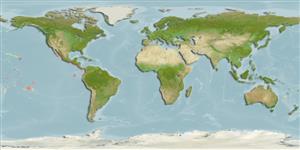Teleostei (teleosts) >
Lophiiformes (Anglerfishes) >
Antennariidae (Frogfishes)
Etymology: Antennatus: From Latin, antenna, antemna = sensory organ, that has got antennae (Ref. 45335).
More on author: Gill.
Environment: milieu / climate zone / depth range / distribution range
Ecology
Marine; demersal; depth range 0 - 38 m (Ref. 9269), usually 0 - 15 m (Ref. 9269). Tropical; 26°N - 0°
Eastern Central Pacific: Gulf of California to Ecuador.
Size / Weight / Age
Maturity: Lm ? range ? - ? cm
Max length : 8.0 cm SL male/unsexed; (Ref. 9269)
Found in small recesses on rocky reefs and especially along walls. They blend almost perfectly with the background, they often take the markings of tube-worm snails or appear to be encrusting sponges (Ref. 5227). Demersal. Found between the surface to 15 m in depth; rarely until 38 m.
Life cycle and mating behavior
Maturity | Reproduction | Spawning | Eggs | Fecundity | Larvae
Oviparous.
Schneider, M. and R.J. Lavenberg, 1995. Antennariidae. Ranisapos. p. 854-857. In W. Fischer, F. Krupp, W. Schneider, C. Sommer, K.E. Carpenter and V. Niem (eds.) Guia FAO para Identification de Especies para lo Fines de la Pesca. Pacifico Centro-Oriental. 3 Vols. FAO, Rome. (Ref. 9269)
IUCN Red List Status (Ref. 130435: Version 2024-1)
Threat to humans
Harmless
Human uses
Fisheries: of no interest
Tools
Special reports
Download XML
Internet sources
Estimates based on models
Preferred temperature (Ref.
123201): 23.6 - 29.1, mean 27.8 °C (based on 222 cells).
Phylogenetic diversity index (Ref.
82804): PD
50 = 0.5002 [Uniqueness, from 0.5 = low to 2.0 = high].
Bayesian length-weight: a=0.02630 (0.01029 - 0.06725), b=2.96 (2.73 - 3.19), in cm total length, based on LWR estimates for this (Sub)family-body shape (Ref.
93245).
Trophic level (Ref.
69278): 3.8 ±0.6 se; based on size and trophs of closest relatives
Resilience (Ref.
120179): High, minimum population doubling time less than 15 months (Fec assumed to be > 10,000).
Fishing Vulnerability (Ref.
59153): Low vulnerability (10 of 100).
